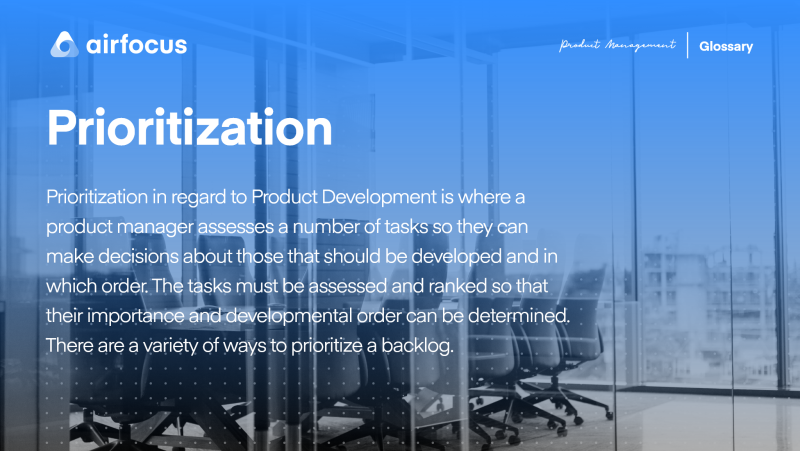Prioritization
What is Prioritization?
Definition of Prioritization
Prioritization in regard to Product Development is where a product manager assesses a number of tasks so they can make decisions about those that should be developed and in which order. Commonly, the tasks are described as a Product Backlog. A roadmap for the development of a product might show the backlog as a variety of tasks, some of which are essential and practical, and others that are more luxurious and aspirational. The tasks must be assessed and ranked so that their importance and developmental order can be determined. There are a variety of ways to prioritize a backlog.
Why Prioritization?
Although the initial premise for a product can be simple, it is easy for it to become complex and convoluted.
Tasks can mount up and a development plan can quickly become turgid. It is critical a Product Backlog does not become a dumping ground for any vague ideas or ambiguous thoughts relating to the product.
Download Now: Get our eBook on Mastering Prioritization
Applying an effective prioritization process can add structure and organization to chaos, and facilitate astute resource allocation while adhering to the organization’s strategic vision. Schedules can be devised and deadlines set.
Some Practices for Prioritization
One strategy to address backlog prioritization is to order your tasks so that those at the top will be the ones employed in the development team’s next sprint. The sprint automatically enables timelines to be set to the tasks in question since the sprint itself is timeline-driven.
Another prioritization strategy is to create a tier-based system for ideas or tasks. In initial discussions with other team members, it will always be useful to capture any concepts as a result of brainstorming sessions.
However, a tiering system will be able to determine which ideas should make it onto the Product Backlog. Through this, the backlog can remain athletic and realistic.
Make sure time has been set aside - and at regular intervals - to review the Product Backlog. Resource availability, an evolving marketplace, commercial competition, and alterations to the organization’s strategic objectives, are just some of the things that can have a profound impact on how a task is prioritized.
Equally, and perhaps in conjunction with creating the tiered system above, keep more aspirational, outlandish, notional, long-term, abstract, fanciful, or obscure ideas within a separate and secure log.
This will eliminate the urge to dump every concept in the backlog and fatten it. Furthermore, schedule time to review the log and consider those items that might be promoted for development.
Consider the use of a scoring system. A mechanism like this can help to maintain the strategic alignment of a task and thus determine its overall commercial value to the organization. Scoring tasks in the backlog in this fashion can make issues such as resource allocation easier to direct.
Further still, developing a robust framework based around the company’s commercial objectives can streamline the whole prioritization process.
This can afford the further advantage of being able to justify any decisions made to wider stakeholders and the leadership team. Aspects of product development to bear in mind when creating a scoring system are time consumption, cost, and specialist knowledge. Other factors specific to an organization’s niche should always be considered too.
Different Types of Prioritizing
Although there are currently a number of ways to prioritize tasks in Product Management, there are always new ways emerging.
Also, any given technique can never be as important as the discussions that take place between staff and the benchmarks agreed upon in the prioritization process.
A) Value vs Complexity Quadrant
In this framework, the business assesses a task based on how complicated it will be to implement compared to its worth. This is a common tool used by product managers. Put plainly, if a task is simple to complete and high in value, its priority will be high.
B) Scoring
This technique is best utilized when considering what is strategically most important to a given business (outside of simply making money). Equally, it can also be used in concert with the value vs complexity type.
A scoring system is dynamic because the criteria for applying the scoring can be forever tweaked, which is especially useful if all the variables impacting an organization remain in flux. A scoring system also aids an objective understanding of the issues influencing the prioritization process.
C) The Kano framework
The Kano concept is based on viewing your product from the point of view of the consumer and their appreciation. Specific features of the product might give the consumer satisfaction (like performance).
Download now: Get our 5-minute guide on How to use the Kano Model
Other product attributes that normally require investment may become less important as a result. In a Kano framework, the product may only have basic features with which to enter the marketplace (threshold) and exhibit only a few attributes that the consumer will have a proportionately high interest in.
D) Pricing
This is based on obtaining feedback from consumers or other stakeholders having asked them what “price” they would place on a particular aspect of the product. A finite total expenditure can be given to the stakeholder or consumer and they can then allocate a price to each aspect of the product. Simply, attributes with the highest prices get the highest priority.
E) Consumer ranking
In this prioritization technique, the idea is to obtain feedback from consumers where they are able to give a rank to each feature of the product based on their appreciation or satisfaction of it. Priorities would then be given to those features that ranked low in customer satisfaction data.
F) Brainstorming
In this method, a team pools all of their ideas. In collaboration, they would then group the ideas based on their similarities.
Once ideas are in their groups, the team would assign them names and proceed to rank the groups based on their perceived importance. By doing this, common attributes emerge and can be prioritized.
G) Story Mapping
This is a technique used more in agile-orientated Product Management and utilizes the Minimum Viable Product (MVP) concept. An MVP is a product that has just enough features to attract early-adoption consumers.
These stakeholders can validate the features of the product. Having this data enables the development team to focus on particular aspects of the product with the assurance that the consumer is already invested in them.
This technique in particular is useful because the product can be released to these pioneering consumers at different intervals for their feedback. This helps to keep the entire roadmap on track and generates valuable data.

General FAQ

Glossary categories
Prioritize with confidence

Experience the new way of doing product management








